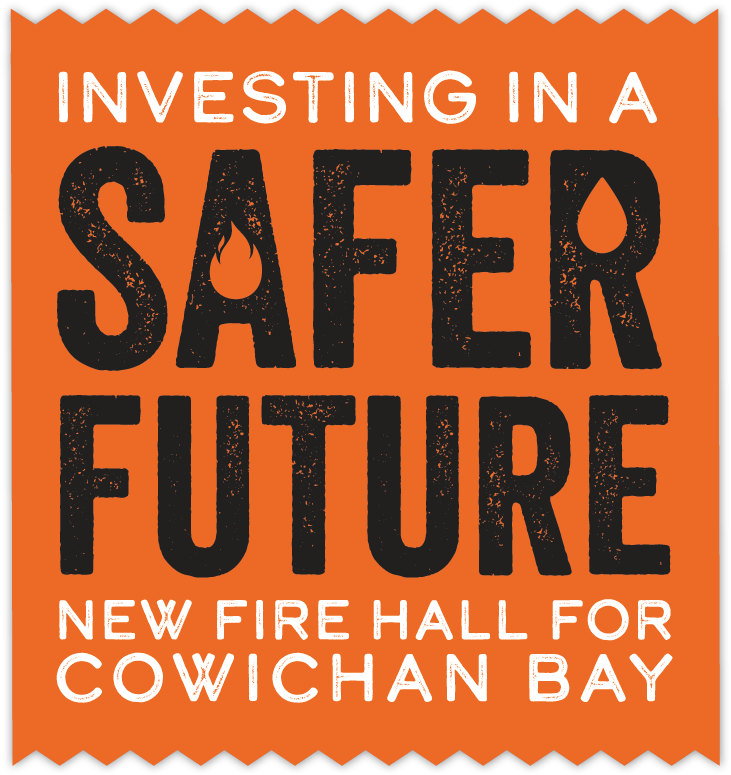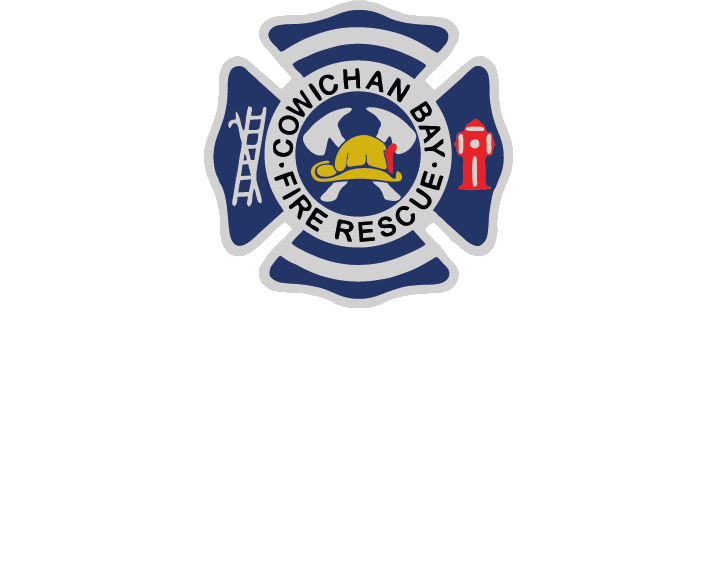
A new fire hall for our community
Fire halls must meet WorkSafe BC requirements, BC Building Code and Fire Code requirements, and industry best practices such as those published by the National Fire Protection Association.
The existing Cowichan Bay fire hall has not had any structural upgrades since it was built in 1977. The long list of issues with the building includes:
- Significant seismic deficiencies (it may collapse in an earthquake)
- Non-compliance with multiple aspects of the BC Building Code meant to ensure safety
- Undersized vehicle bays that require custom-built trucks at great extra cost
- Improper spaces for decontamination after a fire response putting our volunteers in harm’s way
- Improper areas for cleaning and storing fire fighters’ Personal Protective Equipment
- Lack of training space
- Lack of washrooms and showers
- Fire fighters can be exposed to hundreds of contaminants, some of which cause cancer. It is imperative that fire fighters have an area to decontaminate.
- There are 28 volunteer fire fighters currently serving about 10,000 residents.
- A new fire hall will be built to last at least 50 years.
The new fire hall will be built directly behind the existing fire and once the new building is complete, the old one will be demolished.
Detailed cost estimates were conducted in April/May 2022 and the new fire hall is anticipated to cost up to $16 Million, which includes permitting, engineering, total construction, contingency, demolition of the original hall, and interest payments during the construction period. The Improvement District is seeking to borrow this money through the Municipal Finance Authority and repay the loan over 20 years.
Property owners within the area serviced by the Cowichan Bay Volunteer Fire Rescue would pay for the new fire hall annually through property taxes. The new fire hall would cost property owners approximately $43.10 per $100,000 of assessed property value annually over 20 years, beginning when fire hall construction is complete.
According to BC Assessment, as of March 31, 2022, the average residential property within the Improvement District is valued at $820,477. Property owners with a home valued at $820,477 would pay approximately $354 annually towards the fire hall ($43.10 x 8.2 = $354).
Continuing to work out of the existing fire hall is not a long-term option. If we do not take steps now to build a new fire hall, the existing building might eventually have to be closed due to known risks to workers and volunteers. The longer we wait to build a new hall, the more expensive it will be.
Timeline of our fire hall
-
1977
Existing fire hall built
-
1998
First early study on seismic stability, which showed that the fire hall is at significant risk of damage and may collapse in a seismic event.
-
2016
A second seismic study confirmed that the fire hall may collapse in a seismic event.
-
2018
Feasibility study to explore and cost upgrade options.
-
2020
Preliminary costing for upgrade options.
-
March 2021
Citizen advisory committee recommends that the Board pursue fire hall replacement.
-
Summer/Fall 2021
Assembly of a project team (architects, project manager, communications consultants) and construction costing.
-
April/May 2022
Comprehensive community information campaign.
-
June 2 - July 15, 2022
AAP to seek community approval for fire hall funding.
-
Late 2022 - 2024
Design, development permit, and construction tender
-
2024-2025
Construction of new fire hall.
-
2025
Demolition and clean-up of original fire hall.
Answering your questions:
Why is fire hall replacement preferred over renovating the existing hall?
We have been gathering information about upgrade options for number of years. A new hall is preferred over a renovation because: 1) renovation would not be much cheaper (if at all) and would not address all of the issues, 2) building a new hall allows the fire service to continue operating out of the existing building during construction, 3) a new hall will operate for at least 50 years, while a renovation will only renew the building for a limited time.
The Improvement District mobilized a citizen advisory committee in 2020 to review all available information and make recommendations to the board. With respect to cost, the citizen committee recommended that:
“Analysis of all the information made available to the Committee made it clear that the best use of resources is to replace the existing buildings. Options that looked at renovation and additions to the existing building required sacrificing some operational efficiencies and were as expensive as building new.”
What happens if we don’t build a new fire hall?
The existing fire hall is no longer adequate. Either a new fire hall or significant upgrades to the existing building are required. Doing nothing is not an option. There will be costs to area residents in order to maintain fire services for the coming decades.
As background, the Improvement District was created by the Province of BC in 1967 with the purpose of providing fire protection facilities to the area’s residents. The Improvement District has a responsibility to maintain a fire hall that meets WorkSafe BC, BC Building Code, and Fire Code requirements and that reflects industry best practices (e.g. National Fire Protection Association guidelines).
The Improvement District board mobilized a citizen advisory committee in 2020 to review all available information and make recommendations to the board. With respect to cost, the citizen committee recommended that:
“Analysis of all the information made available to the Committee made it clear that the best use of resources is to replace the existing buildings. Options that looked at renovation and additions to the existing building required sacrificing some operational efficiencies and were as expensive as building new.”
How long will a new fire hall last?
A new fire hall will be designed to last a minimum of 50 years.
To what seismic standard will a new fire hall be built?
A new fire hall will be built to post-disaster standards, meaning that it will withstand significant seismic events. The existing fire hall was built to life-safety standards, meaning that it was intended to allow people to escape from the building, but not that it would be safe for ongoing use.
When would a new fire hall be completed?
If funding for a new hall is approved in Summer 2022, construction of a new fire hall is anticipated to be complete in 2025.
How will the new fire hall be paid for?
The new fire hall is anticipated to cost up to $16 Million, which includes permitting, engineering, total construction, contingency, demolition of the original hall, and interest payments during the construction period. The cost could increase or decrease slightly depending on changes to interest rates. The Improvement District is seeking to borrow this money through the Municipal Finance Authority and repay the loan over 20 years.
Property owners within the area serviced by the Cowichan Bay Volunteer Fire Rescue would pay for the new fire hall annually through property taxes. The new fire hall would cost property owners approximately $43.10 per $100,000 of assessed property value annually over 20 years, beginning when fire hall construction is complete.
According to BC Assessment, as of March 31, 2022, the average residential property within the Improvement District is valued at $820,477. Property owners with a home valued at $820,477 would pay approximately $354 annually towards the fire hall ($43.10 x 8.2 = $354).
There are additional details about funding the new fire hall here.
Continuing to work out of the existing fire hall is not a long-term option. If we do not take steps now to build a new fire hall, the existing building might eventually have to be closed due to known risks to workers and volunteers. The longer we wait to build a new hall, the more expensive it will be.
Why is the new Cowichan Bay Fire Hall more expensive than the new Crofton Fire Hall?
This Crofton and Cowichan Bay fire hall replacement projects are very different. The table below explains these differences and the associated costs.
| Crofton Fire Hall | Cowichan Bay Fire Hall |
| Scope: Replacement of the training and administrative areas; continued use of the existing vehicle apparatus bays. | Scope: Brand new facility and demolition of existing facility. |
| Total project area: 3,636 square feet | Total project area: 18,216 sq ft |
| Budget: $4.2 million | Budget: $16 million |
| Population served: around 2,500 | Population served: around 10,000 |
What type of community access will there be to the new Fire Hall?
The new Fire Hall has been designed to include a community room on the south/west side of the building facing the highway. There would be designated public parking (with separate parking for fire responders only) and the community room would have its own entrance from the outside. The community room would be adjacent to washrooms and the commercial kitchen, and access to all other areas of the Fire Hall would be restricted. The community room could be reserved by neighbourhood and community groups, with the understanding that fire service needs would take priority.
The Improvement District has included this community room in the new Fire Hall design to enhance its role in community life, as well as provide important mustering or response space that could be used in the event of a large-scale emergency. Providing a gathering area for the community will be an ongoing part of the new Fire Hall’s role over the coming 50 years.
How can I support the fire hall replacement project?
Community support is essential for us to build a new fire hall. You can support this project by using your voice – telling others why you support a new fire hall for the volunteer fire rescue and helping clarify any misinformation that you hear.
How many of the Fire Department’s call outs in 2021 were fire related, medical aid, or automobile accidents?
In 2021, Cowichan Bay Volunteer Fire Rescue’s distribution of calls was roughly:
- Fire Related: 41%
- Automobile accidents: 25%
- Alarm response (fire, smoke, carbon monoxide, natural gas alarms) 15%
- Assistance (e.g. flooding assistance) 9%
- Medical aid: 8%
- Hazardous material response and rescue 2%
The distribution of calls is generally quite similar from year-to-year.
Does the Cowichan Bay Improvement District provide service to nearby Reserve Lands?
Yes, the Cowichan Bay Volunteer Fire Rescue services a number of homes on Reserve Lands for an annual fee per home.
What does a new fire hall mean for residents of Arbutus Ridge?
Owners of Arbutus Ridge properties within the Cowichan Bay Improvement District are eligible to support or oppose the borrowing of funds to build a new Cowichan Bay Fire Hall in an Alternative Approval Process taking place this Summer.
If funding for a new fire hall receives support, residents served by the Cowichan Bay Volunteer Fire Rescue, including those residents in Arbutus Ridge, will participate in repaying the loan over a 20-year period.
To find out whether your property is located within the Cowichan Bay Improvement District, you can look at a previous years’ property tax bill and see what organization is listed for fire services. If you are uncertain, you can email your address to aap@cbvfr.com and ask us to confirm.



Governing body for the Cowichan Bay
Volunteer Fire Rescue since 1967.
(250)743-7111 | aap@cbvfr.com
